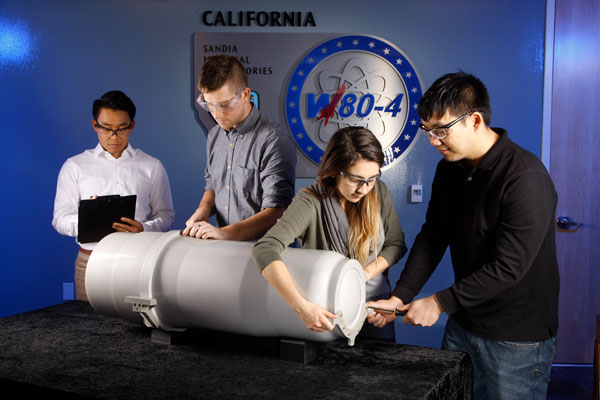
The W80-4 Life Extension Program achieved a major milestone last month when the joint DOE and Department of Defense Nuclear Weapons Council approved the program to enter Phase 6.3, development engineering. The approval follows multiple briefings by the W80-4 leadership team to program stakeholders at NNSA headquarters and the Pentagon.
The move into Phase 6.3 signals the program’s readiness to advance the conceptual design developed during Phase 6.2, the feasibility study and option down-select. Through analysis, testing and qualification activities, design teams at Sandia and Lawrence Livermore national laboratories will gather critical qualification evidence and ensure designs meet extensive customer requirements. The teams also will partner with multiple NNSA production agencies to ensure production readiness of the design.
Members of the management team who helped lead the three-year project expressed pride in the team’s accomplishments and praised the hard work and dedication of the core team, as well as the individuals and teams across the Labs who supported program.
During Phase 6.2, the W80-4 team developed design options and conducted trade studies and analyses. The technical and program teams grew substantially during the Phase 6.2 work to meet the needs of a thriving program, deploying staff to address risk, requirements, quality, nuclear safety and security, surveillance, qualification, configuration and information management, change control and more.
Phase 6.2 included a design definition and cost study period, Phase 6.2A. Throughout this phase, the team pursued rigorous schedule and cost analysis activities using resource-loaded schedules. They conducted a formal schedule and cost, risk and uncertainty analysis to estimate program cost. The work conducted throughout Phase 6.2 and Phase 6.2A culminated in the submission of the weapon design and cost report package, which included the Phase 6.2 study report and the major impact report, documents required before entering Phase 6.3.
The W80-4 program management further prepared for Phase 6.3 by restructuring roles and responsibilities. Weapons engineering centers in California and New Mexico are partnering to support the growth and execution of the W80-4 program. The New Mexico center brings valuable lessons learned and broad experience from other recent modernization programs.
As a joint DoD/DOE unit, the Nuclear Weapons Council facilitates interagency cooperation and coordination. The council also establishes priorities for maintaining and managing the U.S. nuclear weapons stockpile. It holds approval authority for the progress of life extension programs throughout the weapon development process.
Sandia and Lawrence Livermore are the design agencies for the W80-4 Life Extension Program modernization, with responsibility for development of nonnuclear and nuclear components, respectively. The W80-4 LEP is the first modernization program in more than 20 years to refurbish a warhead in parallel with development by the U.S. Air Force of a new delivery platform — the long-range stand-off cruise missile.
In addition to working closely with Air Force partners and contractors, the Sandia W80-4 team collaborates across the nuclear security enterprise with Lawrence Livermore and Los Alamos national labs, Kansas City National Security Campus, Pantex Plant, Y-12 National Security Complex, Savannah River Site and the NNSA program office in Albuquerque.